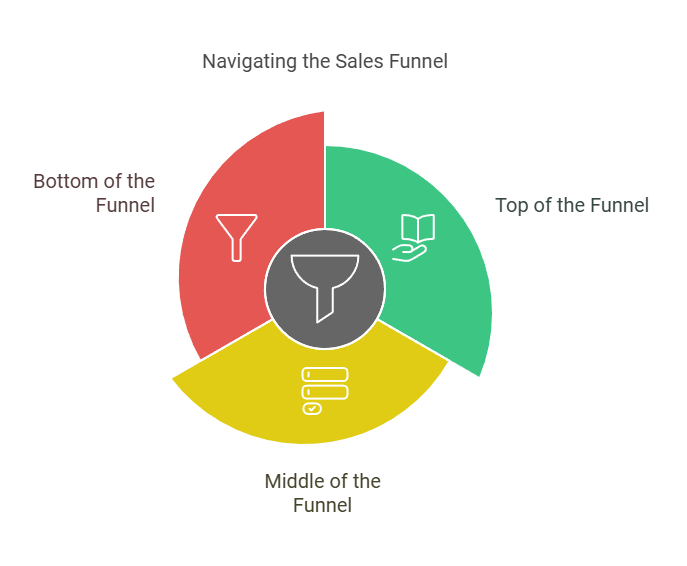B2B lead generation has never been more complex—or more critical. With shrinking attention spans, longer buyer journeys, and increasingly sophisticated decision-makers, the old playbook of cold calls and static email blasts has become obsolete. Businesses now require a B2B lead generation service that is not only intelligent and multi-channel, but also deeply integrated with sales and marketing operations.
The Anatomy of a High-Performance B2B Lead Gen Service
A successful B2B lead generation engine is not a single campaign or a single tool. It is a coordinated ecosystem with multiple components, including:
- Targeted data acquisition
- Lead scoring and segmentation
- Multi-touch engagement via email, ads, and content
- Marketing automation and CRM integration
- Performance analytics and continuous optimization
Each of these components must be aligned not only with each other, but also with the organization’s broader revenue goals. When they are, lead gen becomes predictable, scalable, and accountable.

Building a Foundation: Precision Targeting with Better Data
Effective lead generation begins with knowing exactly who you’re targeting. This involves more than just job titles or firmographics; it includes technographics, buying intent, content interaction patterns, and behavioral signals.
Key Targeting Variables for Modern B2B Campaigns
| Variable Type | Examples | Use Case |
| Firmographics | Company size, revenue, industry | Basic segmentation and persona mapping |
| Technographics | CRM used, email platform, marketing automation tool | Tailoring messaging and positioning |
| Intent Data | Searches, whitepaper downloads, pricing page visits | Timing outreach for buying-readiness |
| Behavioral Data | Email opens, ad clicks, webinar attendance | Lead scoring and campaign personalization |
Data providers are only as good as their hygiene, update frequency, and integration with your tech stack. B2B lead gen services that blend third-party data with first-party behavioral insights tend to deliver more accurate and timely outreach.
From MQLs to SQLs: The Science of Scoring and Segmenting Leads
The B2B buyer’s journey rarely follows a straight path. A decision-maker might binge your content for weeks, go dark, then re-engage after a webinar invite. The goal of a B2B lead gen service is not to force a sale at the wrong time, but to understand buyer intent and deliver value at the right moments.
Lead scoring—both demographic and behavioral—helps prioritize who gets contacted, how, and when.
Sample Lead Scoring Matrix
| Criteria | Score Weight | Notes |
| Title: Director+ | +10 | Decision-making authority |
| Company Revenue > $50M | +8 | Purchasing power |
| Opened 3+ emails | +5 | High engagement |
| Clicked pricing page | +10 | Strong buying intent |
| Attended webinar | +7 | Mid-funnel activity |
| Unsubscribed | -20 | Disqualifying action |
Sophisticated lead gen services often automate scoring with marketing automation platforms and route high-scoring leads to sales reps in real-time, reducing lag and maximizing conversion potential.
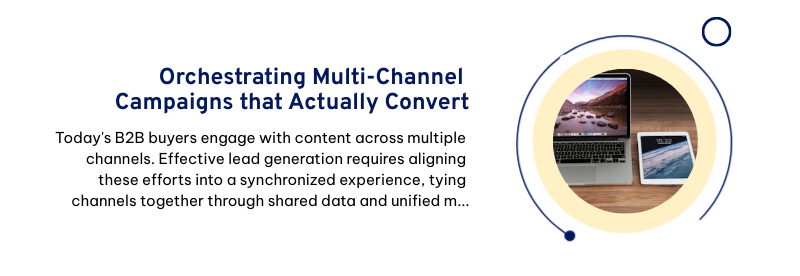
Orchestrating Multi-Channel Campaigns that Actually Convert
Gone are the days when a single channel could carry a campaign. B2B buyers consume content in layers—from top-funnel blog posts to bottom-funnel case studies—and across formats, including email, paid media, and social. The challenge is aligning these efforts into a synchronized experience.
Multi-Channel Campaign Flow Example
- Inbound Trigger: Prospect reads a blog post on a specific solution.
- Retargeting Ad: They see a display ad with a free webinar invite.
- Email Nurture: Post-registration, they receive a 3-part drip campaign.
- Lead Score Spike: Based on content interactions.
- Sales Alert: SDR is notified with activity timeline and contact info.
Campaigns that tie channels together through shared data and unified messaging outperform disjointed efforts by as much as 300%, particularly in enterprise sales environments.
Integrating Marketing Automation for Lead Velocity and Scale
Marketing automation platforms are the heartbeat of any B2B lead gen system. But simply owning a platform like Marketo, HubSpot, or Pardot is not enough. True automation maturity comes from:
- Behavioral-based triggers
- Progressive profiling
- Automated list segmentation
- CRM integration
- Lifecycle stage transitions
One critical advantage of automation is the ability to execute personalized experiences at scale. For example, a new contact can be automatically funneled into a tailored journey based on their industry and job function—with different subject lines, content offers, and CTAs.
Closing the Loop: Aligning Lead Gen with Sales Readiness
Many organizations still struggle with the “black hole” effect—marketing hands off a lead, and sales either ignores it or mishandles it. Modern B2B lead gen services eliminate this gap by integrating with CRM systems, enforcing clear SLAs, and tracking outcomes.
Best Practices for Alignment:
- Define MQL and SQL criteria together
- Set feedback loops on lead quality
- Track downstream impact (pipeline, closed-won, churn)
- Hold regular sales-marketing syncs
When both teams agree on lead definitions and expectations, handoffs become seamless—and results improve.
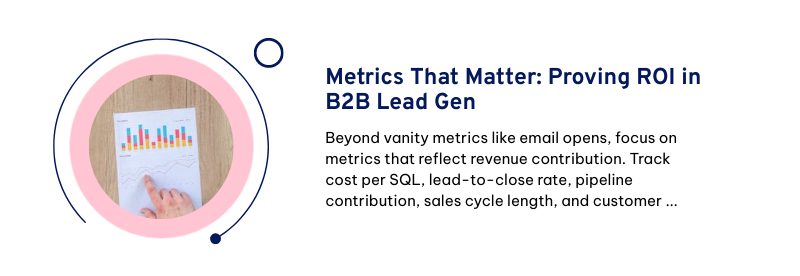
Metrics That Matter: Proving ROI in B2B Lead Gen
A B2B lead gen service is only as good as its reporting. Yet many organizations still rely on vanity metrics—like email opens or impressions—that do not reflect revenue contribution.
The most valuable metrics include:
| Metric | Why It Matters |
| Cost per SQL | Efficiency of moving prospects to sales |
| Lead-to-Close Rate | Sales effectiveness with marketing leads |
| Pipeline Contribution | Total pipeline attributed to marketing |
| Sales Cycle Length | Speed of conversion from first touch |
| Customer Acquisition Cost (CAC) | Marketing and sales spend per customer |
Advanced lead gen services also offer multi-touch attribution models, giving insight into which campaigns, content, or channels drive outcomes—not just clicks.
Demand Generation vs. Lead Generation
Although often used interchangeably, demand generation and lead generation are distinct functions with different goals, timelines, and strategies. Understanding the nuance between them is essential when designing a high-performing B2B lead generation funnel.
- Demand generation aims to build awareness and educate the market. It prioritizes thought leadership, brand equity, and market positioning. Metrics typically include content engagement, website traffic, and social shares.
- Lead generation, by contrast, focuses on capturing information and initiating a sales conversation. Its success is measured in form fills, qualified leads, and eventual conversions.
Mature B2B organizations build both in tandem—leveraging demand generation to feed the top of the funnel and lead generation to convert awareness into pipeline.
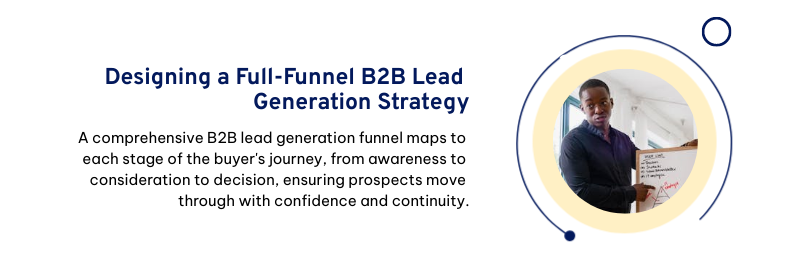
Designing a Full-Funnel B2B Lead Generation Strategy
A comprehensive B2B lead generation funnel should map to each stage of the buyer’s journey—awareness, consideration, and decision. This funnel is not static; it must evolve with buyer expectations, channel preferences, and competitive dynamics.
Funnel Stage Breakdown
| Funnel Stage | Buyer Intent | Content Type | Lead Gen Tactic |
| Awareness | Exploring challenges | Blog posts, infographics, videos | SEO, paid social, display ads |
| Consideration | Comparing solutions | Webinars, white papers, case studies | Email nurture, retargeting ads |
| Decision | Ready to talk to vendors | Demos, ROI calculators, testimonials | Sales outreach, live chat, ABM |
An effective B2B lead gen service ensures prospects are not only moving through these stages—but doing so with confidence and continuity.
Inbound vs. Outbound Lead Generation: Finding the Right Balance
Both inbound and outbound lead generation play pivotal roles in a complete strategy. The key lies in when and how to deploy each approach.
- Inbound lead generation is rooted in attraction. Through SEO, content marketing, and webinars, companies draw prospects into the funnel by offering value and earning trust.
- Outbound lead generation relies on proactive outreach—through cold email, teleprospecting, and targeted ads—to initiate conversations with high-potential accounts.
While inbound often delivers higher-quality leads over time, outbound offers speed, control, and scalability—especially in account-based selling environments. High-performing teams create alignment between the two by using inbound to warm up audiences and outbound to accelerate contact.
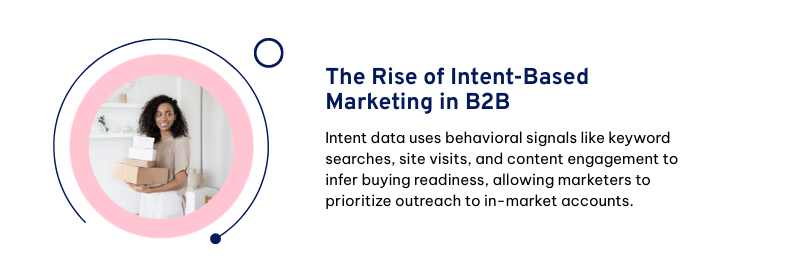
The Rise of Intent-Based Marketing in B2B
One of the most transformative trends in B2B lead generation is the adoption of intent-based marketing. Unlike traditional segmentation, intent data uses behavioral signals—such as keyword searches, site visits, and content engagement—to infer buying readiness.
Intent signals can come from:
- Third-party data providers tracking digital behavior across the web
- First-party platforms monitoring on-site activity and email engagement
- Platforms that aggregate firm-level buying patterns
This allows marketers to prioritize outreach to accounts that are already in-market, increasing conversion rates and shortening sales cycles.
For example, if a mid-size software firm is suddenly consuming content on marketing automation platforms, and your product fits that category, that intent signal is a cue to initiate engagement.
Account-Based Marketing: Personalization at Scale
For many B2B firms—especially those selling to enterprise buyers—account-based marketing (ABM) offers a more effective approach than volume-driven lead generation.
Instead of casting a wide net, ABM targets a defined list of high-value accounts with hyper-personalized campaigns. These efforts are tightly aligned with sales and measured by account-level engagement, pipeline influence, and deal velocity.
Key components of successful ABM include:
- Account selection: Based on firmographics, technographics, or predictive scoring
- Personalized content: Tailored assets for each buying role or vertical
- Cross-channel orchestration: Email, ads, direct mail, and events working in sync
- Joint accountability: Marketing and sales collaborating on follow-up and measurement
While ABM requires more upfront coordination, it often delivers significantly higher ROI and deeper customer relationships.
Advanced Lead Nurturing Strategies
Many leads don’t convert immediately—and that’s where lead nurturing becomes essential. Rather than dropping off after the first interaction, effective nurturing keeps the brand top-of-mind while building trust and accelerating interest.
Modern lead nurturing strategies include:
- Progressive Drip Campaigns: Timed sequences of emails based on content engagement and lifecycle stage
- Dynamic Content: Website modules and emails that change based on industry, persona, or past behavior
- Behavior-Based Triggers: Automated workflows launched when a lead visits a key page, downloads a white paper, or engages with a webinar
- Retargeting: Ads that keep warm leads engaged across social and display networks
The goal of nurturing is not just to move leads down the funnel, but to do so with relevance and precision.
Equipping Sales with Tools for Better Lead Conversion
Even the most sophisticated lead gen system will underperform if sales is not enabled to close. This is where sales enablement intersects with lead generation—providing reps with the context, content, and tools they need to engage effectively.
Core Sales Enablement Elements for B2B Lead Gen
- Lead Intelligence Dashboards: Insights into a lead’s engagement history, content viewed, and firmographic data
- Battle Cards: Quick-reference sheets on how to position against competitors
- Email Templates and Sequences: Proven outreach messages that align with nurture content
- Video Messaging Tools: Personalized video follow-ups to stand out in crowded inboxes
When sales teams are equipped with this data and support, they not only close faster—they also provide feedback loops that help refine marketing strategies.
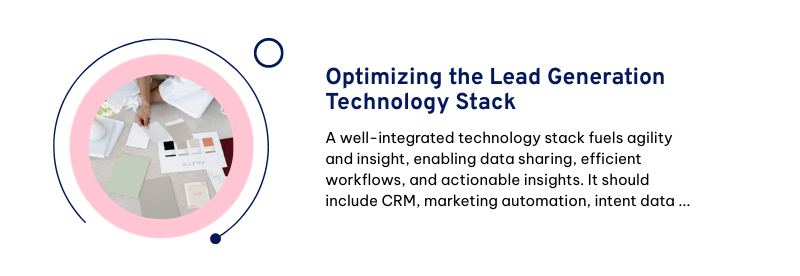
Optimizing the Lead Generation Technology Stack
Marketing technology can either empower or impede your lead generation efforts. A fragmented tech stack leads to data silos, missed signals, and manual inefficiencies. An integrated stack, however, fuels agility and insight.
At a minimum, a B2B lead gen stack should include:
- CRM System (e.g., Salesforce, HubSpot CRM): Centralized contact and opportunity tracking
- Marketing Automation (e.g., Marketo, Pardot, ActiveCampaign): Nurture flows, lead scoring, segmentation
- Intent Data Platforms (e.g., Bombora, G2, ZoomInfo): Signal tracking and predictive scoring
- ABM Orchestration Tools (e.g., Demandbase, Terminus): Personalized, account-level engagement
- Analytics and BI Tools (e.g., Tableau, Domo, Google Looker): Custom dashboards and funnel analysis
Success comes from more than just owning these tools—it depends on how well they’re configured, integrated, and adopted by users.
Common Pitfalls in B2B Lead Generation—and How to Avoid Them
Despite best intentions, many organizations fall into traps that erode performance:
- Over-reliance on a single channel: Email might work now, but overuse can lead to fatigue and unsubscribes
- Neglecting database hygiene: Outdated or duplicate records waste time and lower deliverability
- Misaligned lead definitions: Marketing’s MQL may not meet sales’ SQL criteria
- Unclear attribution models: Not knowing what’s working makes optimization impossible
- Underinvesting in content: Without valuable content, even the best outreach efforts fall flat
Regular audits, cross-team workshops, and performance reviews help avoid these pitfalls and keep the system healthy.

Choosing the Right B2B Lead Gen Service Partner
If you’re outsourcing or augmenting internal efforts, the right lead gen partner can offer more than tactics—they bring systems thinking and cross-channel integration.
Key evaluation questions:
- Do they understand your sales cycle and target persona?
- Can they integrate with your CRM and automation stack?
- What data enrichment capabilities do they offer?
- How do they report on pipeline and ROI?
- Are they agile enough to pivot strategies mid-campaign?
Vendors who prioritize long-term success over short-term volume are better suited for complex, high-consideration B2B environments.
Closing Thoughts: A System, Not a Series of Tactics
The most successful B2B companies treat lead generation not as a set of disconnected campaigns—but as a system. This system is powered by data, enriched by content, and executed through automation. It is refined continuously by feedback from analytics and sales performance.
Whether you’re scaling a startup or optimizing an enterprise pipeline, the principles remain the same:
- Focus on the right buyers
- Deliver value before asking for time
- Track what matters, not what’s easy
- Align every piece—data, tech, content, people—around the buyer journey
With this approach, B2B lead gen becomes more than a function. It becomes a growth engine.


